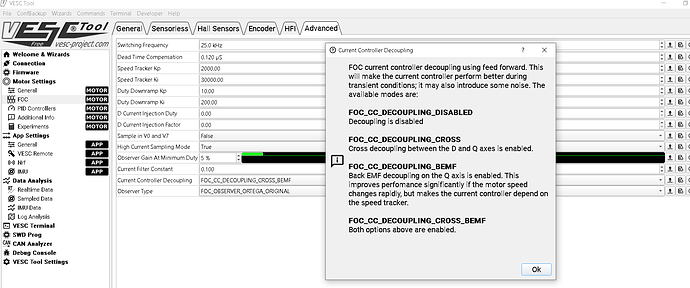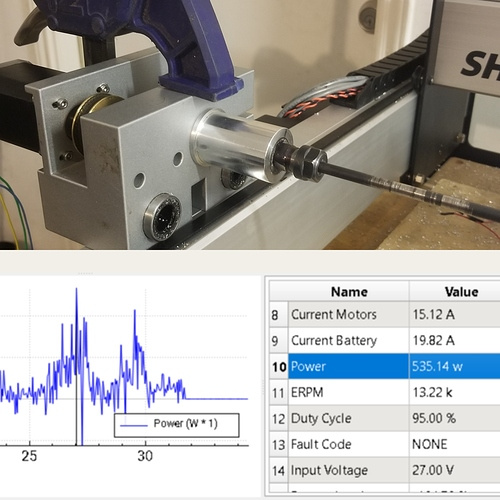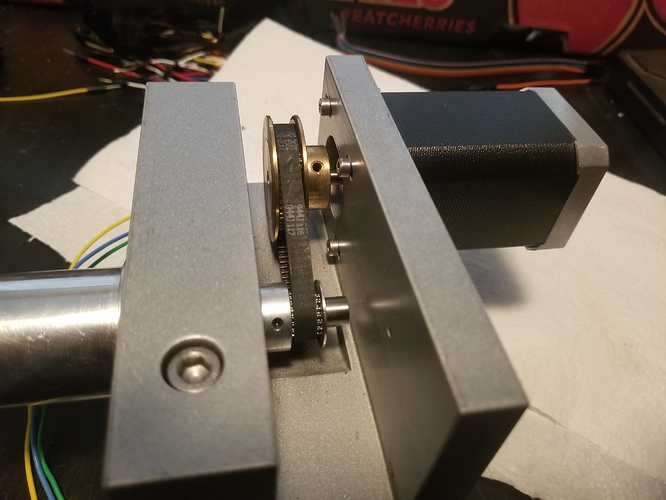IMO it’s more likely that the VESC can’t run FOC sensorless that fast. @Vince.Fab - Reduce speed to a minimum with no load and see if d and q axis currents and voltages show up in the logfile?
Maybe this will mean something?
And I am running ancient hardware so who knows. The main thing is that it is working.
Here is a CSV of it running in manual speed control mode to target rpm. PID is definitely the way to go.
Data now shows d and q currents - so apparently running FOC now.
I don’t think it will tell me the kv directly but if I use a formula it comes out like this.
19500 (max unloaded erpm) / 0.95 (duty cycle) / 4 pole pairs / 27 volts = 190Kv?
That was loaded and 190 was unloaded which I read kv should be measured at.
I forgot, I meant to ask. Did you notice any extra heat from the motor when you were running at 500W?
It did heat up quite a bit but even the stock controller would do that. Keep in mind I haven’t put sustained constant loads on the spindle yet. More power has to equal more heat right. Its going to need some type of active cooling imo.
Also you can attach a temp sensor to the motor and monitor that as well.
So, VESC says that it is 190 RPM/V unloaded?
It sounds about right.
Nomad 190kv × 27 volts = 5130 x 2.5 ratio= 12825 x 0.95 max duty cycle = 12,183 spindle rpm. That’s close enough to what I was seeing.
Its interesting, the Bantam PCB Mill uses a 1000kv outrunner.
Yes, yes it does…
But what kind of monster is that motor!? How would I use a 50kRPM motor on the Nomad? Is it safe to hook it up to the existing spindle and belt?
That’s a good question, the belt appears to be a 2MGT from the pics I’ve found so the Gates design manual for those belts is helpful.
There are notes stating that Vee groove belts are better suited to high speed applications than toothed.
These speeds would be, literally, off the chart for the 2MGT belt, see pp 17
from pp 12 step 2D calculating the Belt Speed using the supplied formula is key
pp 64-66 describe the tensioning requirements, Formula 1 on pp65 expresses static tension in terms of the desired belt speed. Once calculated these radial forces may be well over what the bearings in a normal BLDC motor are designed to support.
To add to that you could reverse the gear ratio. Rather than a 2.5:1 run it 1:2.5. This would increase the torque and reduce the RPM. You would have a max RPM of 20k.
Space constraints are real with the Nomad, it’s not possible to flip the pulleys but you can fit a 1.25" OD max pulley on the spindle. It will need machining to have clearance.
Definitely a double O ring instead of the belt.
The belt speed limits are apparently dictated by the smallest diameter gear’s RPM in that chart. That motor and spindle running at 20 kRPM would have about the right amount of torque for a stock Nomad with a 1/4" endmill. Gates 3M HTD belts could do that based on the chart on page 41. If the spindle can handle that speed and both the spindle and motor can handle the required belt tension, that could double the MRR of stock Nomads without increasing forces. 50 kRPM would increase it by another factor of 2.5 - too bad the bearings in the motor aren’t well suited for direct use as a spindle!
That’s a swap to new pulleys as well as the belt then?
Did you check what static tension was going to be needed for those belts at that belt speed? Don’t want another wrecked motor from overtension situation like on the Shapeoko belts.
Nope, nor do I have any idea of how much speed or radial force the spindle is capable of, or if there is a way to get to 50 kRPM - which would be much better.
I hadn’t heard about that.
Hopefully in the motor specs there’ll be a max radial and axial load rating.
As for the spindle, the radial loads should be fine as it’s designed for cutting, if it can’t handle the belt static tension then the other end will be a problem. As for speed, as you say, we don’t know what it’s balanced to or what the bearings are good for.
There’s been a few posts from folks who’ve suffered broken stepper shafts after belt tightening, when I measured the actual belt tensions and then started checking the specs of similar stepper motors I came across warnings from manufactuers of fatigue failure causing shafts to snap if the radial load was exceeded peristently. We don’t want to do the same thing to the BLDC here.


